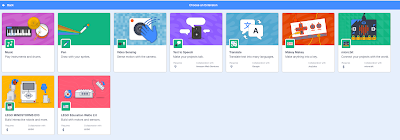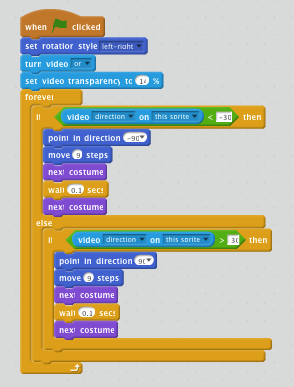
Building an artificial neuron in Scratch
Build yourself a Crumble Eggbot from junk
Full details athttp://bit.ly/2yZ3dZT
There was three inspirations for this project ·Eggbot -http://www.instructables.com/id/Plastic-Egg-Bot/?utm_content=buffer9b065&utm_medium=social&utm_source=twitter.com&utm_campaign=buffer ·Femi Owolade supported by Nic Hughes ran a session at Mozilla Festival 2016 using the Crumble’s to make a wheeled robot. ·The junkbot projecthttps://junkbots.blogspot.co.uk/ Kit ·Kinder Egg (without the Chocolate and toy) ·Crumble also available at https://redfernelectronics.co.uk/crumble/ ·4x Crocodile clips and leads ·Battery pack and 3xAA ·Vibrating motor ·Tape (lots of)
There was three inspirations for this project ·Eggbot -http://www.instructables.com/id/Plastic-Egg-Bot/?utm_content=buffer9b065&utm_medium=social&utm_source=twitter.com&utm_campaign=buffer ·Femi Owolade supported by Nic Hughes ran a session at Mozilla Festival 2016 using the Crumble’s to make a wheeled robot. ·The junkbot projecthttps://junkbots.blogspot.co.uk/ Kit ·Kinder Egg (without the Chocolate and toy) ·Crumble also available at https://redfernelectronics.co.uk/crumble/ ·4x Crocodile clips and leads ·Battery pack and 3xAA ·Vibrating motor ·Tape (lots of)
Free Computing Resource: Junkbots and Scratch 1
The Junkbots project has been running for a number of years as an initiative to bring sustainability, computing and engineering together by building bots out of junk details of the project can be found at. https://junkbots.blogspot.com/. Junkbot is an extension of the Research into teaching problem-solving going on at the University of Northampton
visit https://computingnorthampton.blogspot.com/2019/01/problem-solving-research-outputs-and.html for more details.
One of the criticism of the robot programming part of the Junkbots project is not everyone necessarily gets a go at the programming. To address this a new feature has been added to the project, using Scratch to play with the ideas. This is the first of a set exercises to play with these ideas. The cleaning robot shown is loosely based on the LEGO Mindstorms RCX.
The commands all in the My Blocks section
Exercise 1: Moving the Robot Cleaner around.:
Now go to https://scratch.mit.edu/projects/384342734 and rewrite t…
One of the criticism of the robot programming part of the Junkbots project is not everyone necessarily gets a go at the programming. To address this a new feature has been added to the project, using Scratch to play with the ideas. This is the first of a set exercises to play with these ideas. The cleaning robot shown is loosely based on the LEGO Mindstorms RCX.
The commands all in the My Blocks section
Exercise 1: Moving the Robot Cleaner around.:
Now go to https://scratch.mit.edu/projects/384342734 and rewrite t…
Activity: Writing a translation program in Scratch
Scratch 3 the gift that keeps on giving; including the new extensions are Text to Speech and Translate; Text to speech - does as the name suggests, turns typed in phrases into speech via Amazon Web Services. Translate using Google (and I assume Google Translate?) to translate text between different languages.
As an experiment, I wanted to play with clapping my hands, have Scratch the Cat ask me to enter a phrase and then convert that into French, German and Spanish with different voices. The resulting code is shown below.
It is all started by a loud noise like a hand clap. The two extensions have been added to the blocks and are ready to go. The voice is initially set to Alto and the text-speech block has had the phrase "Please enter a phrase" typed in and says this. The ask block has the same question permanently set and the answer produced gets feed into the translations.
The remaining blocks do essentially the same thing
- change the voice;
- take the phrase typed in (via ans…
As an experiment, I wanted to play with clapping my hands, have Scratch the Cat ask me to enter a phrase and then convert that into French, German and Spanish with different voices. The resulting code is shown below.
It is all started by a loud noise like a hand clap. The two extensions have been added to the blocks and are ready to go. The voice is initially set to Alto and the text-speech block has had the phrase "Please enter a phrase" typed in and says this. The ask block has the same question permanently set and the answer produced gets feed into the translations.
The remaining blocks do essentially the same thing
- change the voice;
- take the phrase typed in (via ans…
Activity: unplugged and plugged computing resource- Thomas' Tangles
In the 9th Edition of the Hello World, Thomas' Tangles has been published (pg 74-75 just follow the link to download the whole magazine for free https://helloworld.raspberrypi.org/issues/9), as part of an issue focussing on Computing and the Arts in schools. Hello World is a magazine for educators with an interest in computing and digital making, published by the Raspberry Pi Foundation.
This activity is aimed at showing that using an algorithm, we can start producing drawings without a computer but with dice, squared paper and pens. Originally, it was developed as an unplugged (without a computer) activity within a chapter (co-written with Katherine Childs) on Computing and Arts in the edited book
Teaching Computing Unplugged in Primary Schools. The name Thomas' Tangles came from my son who developed the activity with me.
An interesting thing to do (well I enjoy it) is to turn the idea in a Scratch version, for example as in helloworld.cc/tangles.
You might need to play with t…
Problem-solving or computational Thinking
Confession time, this has been a research interest for me, along with a number of colleagues, since around 2005. It started with undergraduate students - investigating teaching and developing problem solving skills as a first step in developing programming skills through the use of LEGO-based robots and graphics based programming for undergraduate students. The main vehicle then for developing the problem-solving skills was the LEGO RCX Mindstorms robotics kits and series of gradually more challenging robot-based tasks.
Lawhead et al (2003) stated that robots “…provide entry level programming students with a physical model to visually demonstrate concepts” and “the most important benefit of using robots in teaching introductory courses is the focus provided on learning language independent, persistent truths about programming and programming techniques. Robots readily illustrate the idea of computation as interaction”. Synergies can be made with our work and those one on pre-object pro…
Lawhead et al (2003) stated that robots “…provide entry level programming students with a physical model to visually demonstrate concepts” and “the most important benefit of using robots in teaching introductory courses is the focus provided on learning language independent, persistent truths about programming and programming techniques. Robots readily illustrate the idea of computation as interaction”. Synergies can be made with our work and those one on pre-object pro…
Pygame : Apollo Lander
In July 2019, I produced, using Pygame Zero and Python, a (very) simple Apollo moonlander game - details on it can be found at https://bit.ly/moonlander_pygamezero.
I wanted to test that I could do the same thing in PyGame (and Python) - literally can I do it.
The lander
has to touch a red rectangle on the surface; the mouse is used to move it in the correct direction. When the lander touches the red rectangle:a sound is playedthe lander resets for another run;the target moves to a new location.
Two images were used
The lander image came from https://www.kissclipart.com/apollo-program-apollo-lunar-module-lander-moon-landing-wgwzny/ shared by Xfanmy. This needed to be shrunk by about x10 to fit.Surface came from Vector Designed By from Pngtree.com
I am trying it out in Trinket (see below); so that there isn't a need to install Python or Pygame first.
You can run it here if you just want to play.
Have a go yourself and please feel free to comment and share what you did to change it. There…
I wanted to test that I could do the same thing in PyGame (and Python) - literally can I do it.
The lander
has to touch a red rectangle on the surface; the mouse is used to move it in the correct direction. When the lander touches the red rectangle:a sound is playedthe lander resets for another run;the target moves to a new location.
Two images were used
The lander image came from https://www.kissclipart.com/apollo-program-apollo-lunar-module-lander-moon-landing-wgwzny/ shared by Xfanmy. This needed to be shrunk by about x10 to fit.Surface came from Vector Designed By from Pngtree.com
I am trying it out in Trinket (see below); so that there isn't a need to install Python or Pygame first.
You can run it here if you just want to play.
Have a go yourself and please feel free to comment and share what you did to change it. There…
Explosions, cats, webcams and Scratch
Still enjoying playing with Scratch and webcam. in this post, initially improving on the example shown in a previous post Webcam and Scratch; enhancing the movement of Scratch the Cat by adding the interim step and facing in the direction of the 'moving finger' (see the code below).
Please go to the code at https://scratch.mit.edu/projects/263334488/ to try it yourself.
Going to add one more feature to experiment with getting objects to react to the motion. In this case to explode a button or change a button to a small ball by moving the finger onto the button. The motion on the sprite is used to do this.
Please try the code yourself at https://scratch.mit.edu/projects/266837380/
All opinions in this blog are the Author's and should not in any way be seen as reflecting the views of any organisation the Author has any association with. Twitter @scottturneruon
Please go to the code at https://scratch.mit.edu/projects/263334488/ to try it yourself.
Going to add one more feature to experiment with getting objects to react to the motion. In this case to explode a button or change a button to a small ball by moving the finger onto the button. The motion on the sprite is used to do this.
Please try the code yourself at https://scratch.mit.edu/projects/266837380/
All opinions in this blog are the Author's and should not in any way be seen as reflecting the views of any organisation the Author has any association with. Twitter @scottturneruon
World of Codecraft: 3-D Game Teaches Kids 'Big Ideas' of Programming | Wired Enterprise | Wired.com
World of Codecraft: 3-D Game Teaches Kids 'Big Ideas' of Programming | Wired Enterprise | Wired.com:
BY KLINT FINLEY 07.19.136:30 AM
ENGAGE, a 3-D game that teaches programming concepts to kids.
Videogames are a waste of time. Well, not always. Sometimes they can teach you stuff, like honest-to-goodness computer programming skills.
The trick is to make these educational games as interesting and enjoyable as the shoot-em-up variety, and that’s not always easy. But researchers at North Carolina State University want to help. Dr. Kristy Boyer and Fernando Rodríguez are studying the way youngsters respond to a 3-D game that teaches programming, hoping to discover the secrets of building games that are not only educational but enjoyable"
'via Blog this'
BY KLINT FINLEY 07.19.136:30 AM
ENGAGE, a 3-D game that teaches programming concepts to kids.
Videogames are a waste of time. Well, not always. Sometimes they can teach you stuff, like honest-to-goodness computer programming skills.
The trick is to make these educational games as interesting and enjoyable as the shoot-em-up variety, and that’s not always easy. But researchers at North Carolina State University want to help. Dr. Kristy Boyer and Fernando Rodríguez are studying the way youngsters respond to a 3-D game that teaches programming, hoping to discover the secrets of building games that are not only educational but enjoyable"
'via Blog this'
The Science of Problem Solving
- Get link
- X
- Other Apps
- Get link
- X
- Other Apps






Comments
Post a Comment